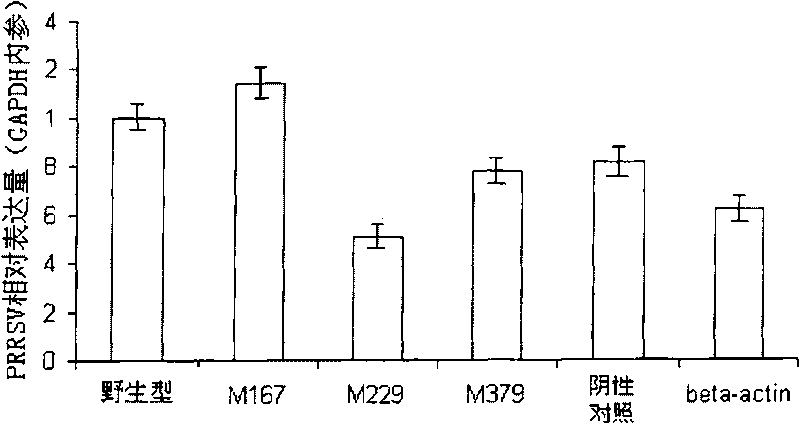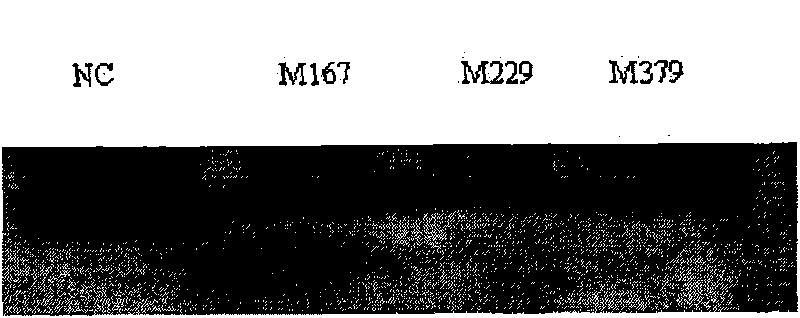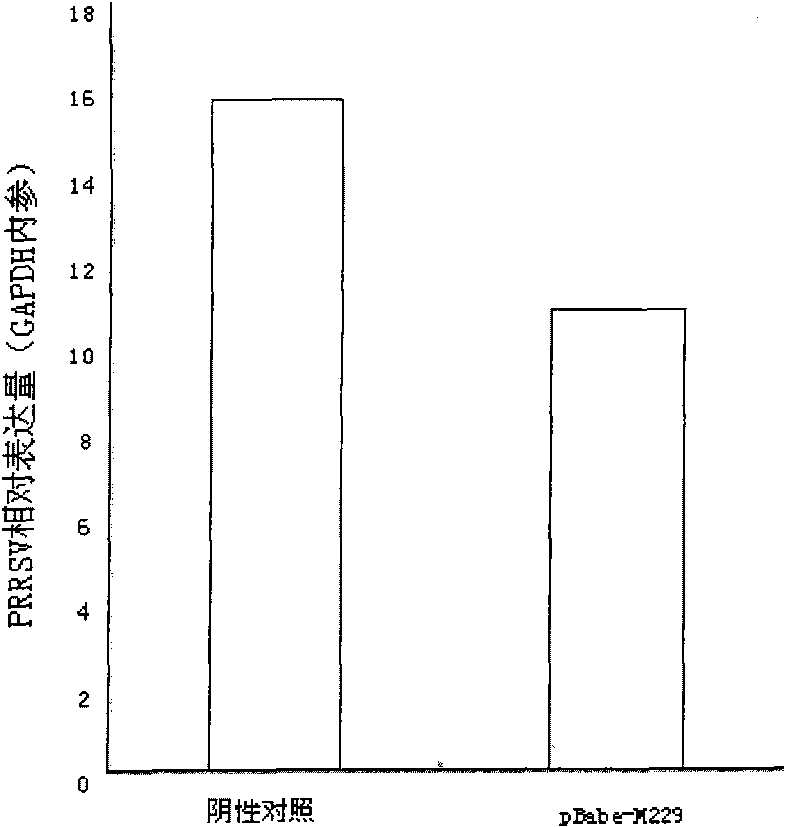siRNA segment and application thereof used for curing and/or preventing porcine reproductive and respiratory syndrome
A technology for respiratory syndrome and pig breeding, applied in the direction of DNA/RNA fragments, applications, gene therapy, etc., can solve problems such as inability to prevent re-infection, difficulty in obtaining vaccine results, and infection of pigs
- Summary
- Abstract
- Description
- Claims
- Application Information
AI Technical Summary
Problems solved by technology
Method used
Image
Examples
Embodiment 1
[0027] Example 1 : Design of RNAi sequences
[0028] siRNA design strategy: 1) Search for the ideal siRNA sequence from 50-100 nucleotides downstream of the start codon AUG of the target gene, the closer to the 3' end of the target gene, the better the gene silencing effect; 2) siRNA The sequence is preferably AA(Nn)UU (N represents any base; n is the number of bases, between 19 and 29 nt), and NA(Nn)UU and NA(Nn)NN sequences are also acceptable. 3) It has a balanced base content (that is, the G / C content is between 30% and 70%). According to the genome sequence of PRRSV S1 strain (GenBank accession number: AF090173), two pairs of siRNA fragments were designed, and their sequences are:
[0029] M-229 (SEQ ID NO.1):
[0030] 5'-GCAGUAGUUGCACUCCUUU-3'
[0031] 3'-CGUCAUCAACGUGAGGAAA-5';
[0032] M-379 (SEQ ID NO.2):
[0033] 5'-GCAAAUGAUAACCACGCAU-3'
[0034] 3'-CGUUUACUAUUGGUGCGUA-5'
[0035] M-167 (SEQ ID NO.3):
[0036] 5'-CCUUCGGGUACAUGACUUU-3'
[0037] 3'-GGAAGCC...
Embodiment 2
[0048] Example 2 : siRNA transfection of Marc145 cell line and PRRSV infection
[0049] Experimental materials: Marc145 cells, American PRRSV S1 strain (MOI=0.01), American PRRSV polyclonal antibody.
[0050] 1. Transfection: Marc145 cells were incubated with RPMI 1640 medium (GIBCO) containing 10% fetal bovine serum at 37°C and 5% CO 2 cultivated under conditions. Cell transfection was performed using liposome Hiperfect (Qiagen), and the operation method could be completely in accordance with the manufacturer's instructions. For transfection, Marc145 cells (6-well plate) were transfected with 1 μg siRNA.
[0051] 2. PRRSV infection: 24 hours after transfection, PRRSV cytotoxicity (MOI=0.1) was added to each culture plate, and the culture was continued for 24 hours.
Embodiment 3
[0052] Example 3 : Detection of siRNA interference effect
[0053] I. Real-time quantitative PCR (Real-time RCR) analysis:
[0054] 1. Extraction of total RNA
[0055] Total cellular RNA was extracted using Trizol reagent (Invitrogen), and the steps were referred to the instructions of Invitrogen Company.
[0056] 2. Real-time quantitative PCR analysis
[0057] 1) Primer and probe design
[0058] The GAPDH gene of the baboon (Papio anubis) and the beta-actin gene of the long-tailed monkey (C.aethiops) were used as positive controls for the real-time quantitative PCR reaction, and the sequences of primers and probes were designed as shown in Table 1.
[0059] Table 1 GAPDH gene, beta-actin gene and PRRSV-M gene primer and probe sequence
[0060]
[0061] 2) Reagents and instruments
[0062] Reagents: TaqMan (TaqMan) general reagents for real-time quantitative PCR (Shanghai Gemma Biotechnology Co., Ltd.);
[0063] Instrument: FTC-2000A real-time quantitative PCR instr...
PUM
 Login to View More
Login to View More Abstract
Description
Claims
Application Information
 Login to View More
Login to View More - R&D
- Intellectual Property
- Life Sciences
- Materials
- Tech Scout
- Unparalleled Data Quality
- Higher Quality Content
- 60% Fewer Hallucinations
Browse by: Latest US Patents, China's latest patents, Technical Efficacy Thesaurus, Application Domain, Technology Topic, Popular Technical Reports.
© 2025 PatSnap. All rights reserved.Legal|Privacy policy|Modern Slavery Act Transparency Statement|Sitemap|About US| Contact US: help@patsnap.com



